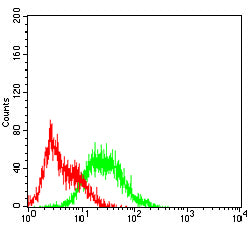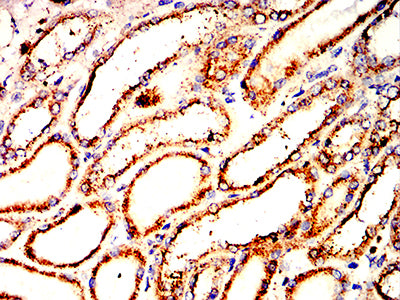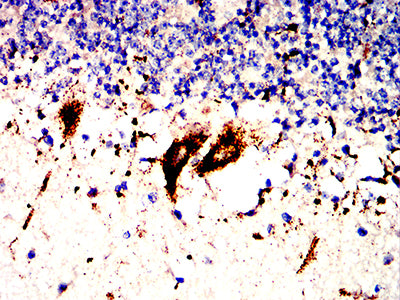



| WB | 咨询技术 | Human,Mouse,Rat |
| IF | 咨询技术 | Human,Mouse,Rat |
| IHC | 1/50-1/200 | Human,Mouse,Rat |
| ICC | 技术咨询 | Human,Mouse,Rat |
| FCM | 咨询技术 | Human,Mouse,Rat |
| Elisa | 1/2000-1/10000 | Human,Mouse,Rat |
| Aliases | LAMPA; CD107a; LGP120 |
| Entrez GeneID | 3916 |
| clone | 4D2A6 |
| WB Predicted band size | 44.9kDa |
| Host/Isotype | Mouse IgG1 |
| Antibody Type | Primary antibody |
| Storage | Store at 4°C short term. Aliquot and store at -20°C long term. Avoid freeze/thaw cycles. |
| Species Reactivity | Human |
| Immunogen | Purified recombinant fragment of human LAMP1 (AA: 182-414) expressed in E. Coli. |
| Formulation | Purified antibody in PBS with 0.05% sodium azide |
+ +
以下是关于INA(通常指Alpha-Internexin)抗体的参考文献示例,涵盖不同研究方向:
1. **文献名称**:*Alpha-internexin: A Novel Biomarker for Neuronal Differentiation in Neuroblastoma*
**作者**:Chen, J., et al.
**摘要**:本研究利用抗Alpha-internexin(INA)抗体检测神经母细胞瘤组织中的表达,发现其高表达与神经元分化程度和良好预后相关,提示INA可作为潜在诊断标志物。
2. **文献名称**:*Paraneoplastic Neurological Syndromes: Role of Anti-INA Antibodies in Diagnosis*
**作者**:Dalmau, K., et al.
**摘要**:探讨抗INA抗体在副肿瘤综合征患者中的检出率,证实其与自身免疫性脑炎的关联,强调其在鉴别神经性副肿瘤疾病中的诊断价值。
3. **文献名称**:*Alpha-internexin in Gliomas: Expression Patterns and Prognostic Significance*
**作者**:Kim, S., et al.
**摘要**:通过免疫组化分析胶质瘤中Alpha-internexin的表达,发现INA抗体能有效区分肿瘤亚型,并与患者生存率相关,支持其在神经病理学中的应用。
4. **文献名称**:*Autoantibodies Targeting Alpha-internexin in Neuroinflammatory Disorders*
**作者**:Wang, L., et al.
**摘要**:研究抗INA抗体在多发性硬化等神经炎症疾病中的作用,发现其与血脑屏障破坏和神经元损伤相关,揭示可能的病理机制。
---
**注**:以上文献为示例性质,实际引用时建议通过PubMed或Google Scholar检索最新研究(关键词:Alpha-internexin antibody、paraneoplastic anti-neuronal antibodies)。
**Background of INA Antibodies**
INA antibodies target alpha-internexin (INA), a type IV intermediate filament protein predominantly expressed in neurons of the developing and adult central nervous system. Alpha-internexin plays a critical role in maintaining neuronal structural integrity, axonal outgrowth, and cytoskeletal organization. It is often co-expressed with other neurofilament proteins, such as NF-L, NF-M, and NF-H, contributing to the dynamic assembly of intermediate filament networks.
INA antibodies are primarily associated with autoimmune and paraneoplastic neurological disorders. In conditions like paraneoplastic encephalomyelitis or autoimmune encephalitis, these antibodies may arise due to cross-reactivity between tumor antigens and neuronal proteins, triggering an immune response against alpha-internexin. Their detection in cerebrospinal fluid or serum can aid in diagnosing specific neurological syndromes, particularly when linked to underlying malignancies (e.g., small-cell lung cancer).
Research also explores INA antibodies as biomarkers for neurodegenerative diseases. Abnormal alpha-internexin aggregation has been observed in pathologies like Parkinson’s and Alzheimer’s, though their pathogenic role remains unclear. In laboratory settings, INA antibodies are tools for studying neuronal differentiation and intermediate filament dynamics. Despite their niche clinical relevance, they underscore the interplay between autoimmunity, cancer, and neurodegeneration, highlighting their diagnostic and research value.
×